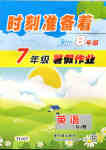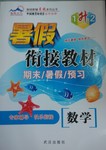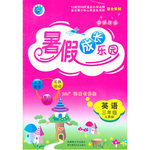
_____ being too large, the color and the style of the dress suit me well.
| A.Apart from | B.As well as | C.Besides | D.Instead of |
 时刻准备着暑假作业原子能出版社系列答案
时刻准备着暑假作业原子能出版社系列答案 暑假衔接教材期末暑假预习武汉出版社系列答案
暑假衔接教材期末暑假预习武汉出版社系列答案 假期作业暑假成长乐园新疆青少年出版社系列答案
假期作业暑假成长乐园新疆青少年出版社系列答案科目:高中英语 来源: 题型:阅读理解
阅读下面短文,按照句子结构的语法性和上下文连贯的要求,在空格处填入一个适当的词或使用括号中词语的正确形式填空, 并将答案填写在答题卡标号为31~40的相应位置上。
Chinese proverbs are rich and they are still widely used in Chinese people’s daily life. 31 these proverbs, there are often interesting stories. For example, the proverb, “plucking up a crop 32 (help) it grow”, is based on the following story.
It is said that a short-tempered man in the Song Dynasty (960 — 1279) was very anxious to help 33 rice crop grow up quickly. He was thinking about 34 day and night. But the crop was growing much slower than he expected.
One day, he came up with an idea 35 he would pluck up all of his crop a few inches. He did so the next day.
He was very tired 36 doing this for a whole day, 37 he felt very happy since the crop did “grow” 38 (high).
His son heard about this and went to see the crop. Unfortunately the leaves of the crop began to wither.
This proverb is saying we have to let things go in their 39 (nature) course. Being too anxious to help an event develop often 40 (result) in the contrary to our intention.
查看答案和解析>>
科目:高中英语 来源:2011届新疆哈巴河县高级中学高二上学期第一次月考英语卷 题型:完型填空
Learning experiences happen to us throughout our lives. Not long ago, I had one that I would like to __16__.
I was going to Marblehead with my sailboat team. The team was racing down the highway at 85 mph __17_ we realized we were __18_. Luckily, we saw a rest area ahead. I had a brand-new $20 bill. I was so __19_ because I had never had that kind of cash before. But spending it on __20__ seemed like throwing it away. We all rushed into the pizza line. __21__ I got a pizza and a drink, and walked to my table. About halfway through the meal, I __22_ I had not actually handed any money to the cashier. I had just __23__ out, and nobody had noticed. I felt terrible.
My conscience (良心) opened its mouth and swallowed me in one big bite. I couldn’t __24__ over it. I just couldn’t go back to the cashier and __25__ for my stolen pizza. I was so upset that I __26__ to give myself the pleasure of an ice cream for __27__ that someone would say, “Hey, Jeff, why not you use the change __28__ the pizza instead of that nice, new $20 bill?” I was not so __29__ of my cash now. For the next two years, whenever I was __30__ of the “pizza incident”, I would say to myself, “Don’t think about it…”
I have learned two things from this __31__. Maybe I was a fool for __32__ in to my conscience, and being too stupid to appreciate a __33__ pizza. But the real lesson is that even if you get away with what you have done, your conscience will __34__ up with you.
This reflects the saying, “Coward (懦夫) dies a thousand deaths, a hero dies one.” I was a coward and have felt terrible about that incident at least a thousand times. If I had been a “__35__” and gone back to pay for the pizza, I would have felt a little uncomfortable about it only one, or maybe twice.
| 【小题1】 |
|
| 【小题2】 |
|
| 【小题3】 |
|
| 【小题4】 |
|
| 【小题5】 |
|
| 【小题6】 |
|
| 【小题7】 |
|
| 【小题8】 |
|
| 【小题9】 |
|
| 【小题10】 |
|
| 【小题11】 |
|
| 【小题12】 |
|
| 【小题13】 |
|
| 【小题14】 |
|
| 【小题15】 |
|
| 【小题16】 |
|
| 【小题17】 |
|
| 【小题18】 |
|
| 【小题19】 |
|
| 【小题20】 |
|
查看答案和解析>>
科目:高中英语 来源:2011-2012学年内蒙古巴市一中高一下学期期末考试英语试卷(带解析) 题型:阅读理解
It seems school children all over the world complain about their school food. Cherie Blair, the wife of Prime Minister Tony Blair, said that she would prepare a packed lunch for her son if school dinners do not improve. So what do students of your age eat for lunch at school?
Japan
High schools have canteens(餐厅), which serve everything from noodles to rice, but not burgers and chips. Other children bring food from home such as cold rice balls, meat or fish, pickles(泡菜) and vegetables.
Students take home a menu for the coming month containing notes on nutrition value. Twice a year parents are invited to have a taste of the food. The class with the fewest leftovers(剩饭) at the end of the month receives a prize.
Untied States
A typical menu from a US school is made up of a hamburger with fried potatoes or roast chicken, lettuce and pickles, fruit and cookies. School lunches must also provide at least one-third of the daily dietary allowances(定量) of protein, vitamin A, vitamin C, iron, calcium, and calories.
Australia
Meat pies, sausage rolls and hotdogs are all traditional dishes in Australian school shops. But as the nation pays more attention to children’s health, healthier foods have started to find their way onto school menus.
Many schools have used a traffic light system. The sale of red-labelled foods, including pastries(点心), chocolate and soft drinks, is served only twice a week. Healthier green-labelled foods such as sushi(寿司), sandwiches, corn and watermelon, however, are available every day.
In some schools, students have a choice of up to 89 foods to choose from, including popcorn and rice.
South Africa
Most of South Africa’s schools do not serve meals at all. Classes end at 1:30pm and students get their own lunches. Many students bring food from home, usually sandwiches.
Fast food and fried food sell the best among students, which has led to a rise in obesity among children. But as more people began to realize the fact that being too fat may cause different diseases, some schools in towns have led the way towards better nutrition. Now students at these schools are provided with lunches of porridge(麦片粥) with vegetables, such as cabbages, onions, beans, carrots and tomatoes.
【小题1】What does the underlined word “obesity ”in the last paragraph probably mean?
| A.Fighting. | B.Sadness. | C.Food shortage. | D.Overweight. |
| A.a typical menu from a US school consists of enough nutrition. |
| B.most students in South Africa eat their lunch at home. |
| C.many schools in Australia have traffic lights outside their school. |
| D.you can have whatever you like in school canteens in Japan. |
| A.Schools should try to satisfy the needs of students. |
| B.Schools serve different foods from country to country. |
| C.Food served in the US is the best of all. |
| D.School children all over the world dislike their school food. |
| A.school lunch suppliers | B.schoolmasters |
| C.students of your age | D.nutritionists(营养学家) |
查看答案和解析>>
科目:高中英语 来源:2011-2012学年重庆市西南大学附属中学高一下学期期中考试英语试卷(带解析) 题型:阅读理解
It seems school children all over the world complain about their school food. Cherie Blair, the wife of previous Prime Minister Tony Blair, said that she would prepare a packed lunch for her son if school dinners do not improve. So what do students of your age eat for lunch at school?
Japan
High schools have canteens(食堂), which serve everything from noodles to rice, but not burgers and chips. Other children bring food from home such as cold rice balls, meat or fish, pickles(泡菜) and vegetables.
Students take home a menu for the coming month containing notes on nutrition(营养)value. Twice a year parents are invited to have a taste of the food. The class with the fewest leftovers(剩饭) at the end of the month receives a prize.
Untied States
A typical menu from a US school is made up of a hamburger with fried potatoes or roast chicken, lettuce and pickles, fruit and cookies. School lunches must also provide at least one-third of the daily dietary allowances (定量) of protein, vitamin A, vitamin C, iron, calcium, and calories.
Australia
Meat pies, sausage rolls and hotdogs are all traditional dishes in Australian school shops. But as the nation pays more attention to children’s health, healthier foods have started to find their way onto school menus.
Many schools have used a traffic light system. The sale of red-labelled foods, including pastries, chocolate and soft drinks, is served only twice a week. Healthier green-labelled foods such as sushi (寿司), sandwiches, corn and watermelon, however, are available every day.
In some schools, students have a choice of up to 89 foods to choose from, including popcorn and rice.
South Africa
Most of South Africa’s schools do not serve meals at all. Classes end at 1:30pm and students get their own lunches. Many students bring food from home, usually sandwiches.
Fast food and fried food sell the best among students, which has led to a rise in obesity among children. But as more people began to realize the fact that being too fat may cause different diseases, some schools in towns have led the way towards better nutrition. Now students at these schools are provided with lunches of porridge with vegetables, such as cabbages, onions, beans, carrots and tomatoes.
【小题1】What does the underlined word “obesity” in the last paragraph probably mean?
| A.Nutrition. | B.Addiction. | C.Food shortage. | D.Overweight. |
| A.a typical menu from a US school consists of enough nutrition. |
| B.most students in South Africa eat their lunch at home. |
| C.many schools in Australia have traffic lights outside their school. |
| D.you can have whatever you like in school canteens in Japan. |
| A.Schools should try to satisfy the needs of students. |
| B.Schools serve different foods from country to country. |
| C.Food served in the US is the best of all. |
| D.School children all over the world dislike their school food. |
| A.parents | B.schoolmasters |
| C.students of your age | D.nutritionists |
查看答案和解析>>
科目:高中英语 来源:2010年广东省中山市高一上学期期中考试英语卷 题型:其他题
阅读下面短文,按照句子结构的语法性和上下文连贯的要求,在空格处填入一个适当的词或使用括号中词语的正确形式填空,并将答案填写在答题卡相应位置上。
Chinese proverbs(谚语) are rich and they are still widely used in Chinese people’s daily life. Behind these proverbs there 1. (be) often interesting stories. For example, the proverb, “plucking up (拔高)a crop to help it grow”, is based 2. the following story.
It is said that a short-tempered(脾气急躁的) man in the Song Dynasty (960—1279) was very anxious to help 3.___ rice crop grow up quickly. He was thinking about this day and night. But the crop was growing much _____4. (slow) than he expected.
One day, he came up with 5.___ idea that he would pluck up all of his crop a few inches. He did so the next day.
He was very tired after doing this 6. a whole day, 7. he felt very happy since the crop did “grow”higher.
His son 8. (hear) about this and went to see the crop. Unfortunately the leaves of the crop began to wither(枯萎).
This proverb 9. we learn through this story is saying we have to let things go in their natural course. Being too anxious to help an event develop often 10. (result) in the contrary to our intention.
查看答案和解析>>
湖北省互联网违法和不良信息举报平台 | 网上有害信息举报专区 | 电信诈骗举报专区 | 涉历史虚无主义有害信息举报专区 | 涉企侵权举报专区
违法和不良信息举报电话:027-86699610 举报邮箱:58377363@163.com